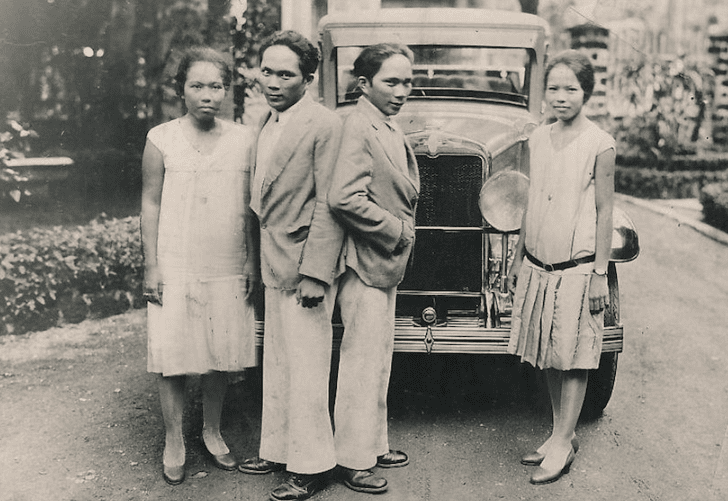‘We are a gift; they call us cursed’– Melvin Villaver on ‘Harmonic Resurgence’
When Lucio and Simplicio Godino died days after being severed apart in December 1936, it took an author with TIME Magazine more than 215 words to mention that the formerly conjoined twins were touring musicians.
The 28-year-old Filipino natives have gone largely unnoticed in the annals of modern music history, only obscurely known for their rare medical condition. Phonographic records existed at the time of their success. Clemson University assistant professor Melvin Villaver has scoured the archives to no avail to track down any audio records of the Godino twins.
That isn’t exactly the case now.
Villaver, who teaches courses in Global Black Studies and Audio Technology, published his mixtape dissertation on February 16, memorializing the deceased twins in an avant-garde work through “Harmonic Resurgence.”
As the son of Filipino immigrants raised in Los Angeles, Villaver holds a sentimental attachment to this work.
“The main goal of my mixtape was to humanize their experience because they absolutely were human,” he said. “To bring their story back into the fold of consciousness because they were forgotten. I didn’t forget about them. It’s a project of reclamation. It’s a project honoring my identity as a Filipino musician to write about, perform and make music from the perspective of deceased Filipino musicians.”
A dissertation comes to life
As a doctoral student in the American Studies program at Purdue University, lead professor Rayvon Fouché asked Villaver if he’d be interested in tapping into his musical expertise for his dissertation. It just so happened that former Clemson doctoral student A.D. Carson had laid the groundwork for such a feat, and Villaver has surrounded himself with music since he was 5 years old.
It is so wonderful to see Dr. Villaver flourish. I find his work pathbreaking. His work grapples with the uneven ways Filipino immigrants are and are not understood. His project studying the complex lived realities of the Godino twins has uncovered some research gems about the Godino brothers that will reshape our perceptions of race and disability. This project not only questions the transnational flows of race and music, but also demands that we understand the ways that disability functions within these contexts.
RAYVON FOUCHÉ, NORTHWESTERN UNIVERSITY SCHOOL OF COMMUNICATION
This project will push the field of Disability Studies to consider the ways that racial and ethnic identities need to be woven into conceptualizations and theorizations of disability. His research will add new and valuable analysis to the study of race, ethnicity, identity, and politics in an increasingly interconnected world. Dr. Villaver’s motivation, research skills and sustained engagement with the transnational flows of ethnicity and race will enable him to develop as an important scholar. Dr. Villaver’s intellectual energy and focus are second to none. I admire his drive to produce work that is intellectually meaningful, socially valuable and culturally significant.
Archival work through the EMI Archive Trust and other sources led Villaver to articles on the twins, who he said were “very popular, rich and famous” in the 1920s and 1930s.
“I couldn’t hear them,” he lamented, “so my research paradigm shifted to, ‘How or what method can I use to turn their story up louder to make it so that I can hear them?’ I have all this information, but I don’t have any soundbites of them singing.”
Villaver said the Godino twins were brought to New York and participated in the Coney Island Freak Show as adolescents.
The 1936 article reported the intricacies of their day-in and day-out lives, as the two were linked at the tailbone. Lucio was the leader who walked forward and slept on his left side.

That winter, Lucio became ill with rheumatic fever after playing in Greenville, North Carolina. A press gaggle gathered to gawk at a private hospital to see what was unfolding to the twins, which ultimately resulted in Lucio dying. Some even believed the case was a twisted publicity stunt.
A surgeon stepped in after the death and conducted the “first operation of its kind” in separating adult conjoined twins, according to the TIME article.
Simplicio died 12 days after the operation from cerebrospinal meningitis.
“Some people say of a broken heart,” Villaver noted.
As for why there is an information shortage on the twins today, Villaver’s theory is that the failed medical experiment required those in power to bury the story and its fatal failure. He also pointed out the outdated and discriminatory label of “Siamese twins” used by Western media.
“It was almost a botched surgery they tried to sweep under the rug. How can you hide a famous botch? Well, you don’t cover it,” Villaver said. “Rayvon Fouché told me that the silence in the archives speaks volumes of who the archive is meant to preserve and protect.”
‘It’s a ghost story’
The 11-track tape clocks in with a run time of slightly under 32 minutes. It is precise and fluid. There are no filler tracks as the musical technician weaves a life tale of the Godino twins leading up to their deaths, with odes on love and the rarity of owning a Rolls-Royce Phantom as minorities at the time. A penultimate track titled “Farewell” imagines the final conversation between Lucio and Simplicio before being severed.
“This is an experiment I doubt we’ll endure,” Villaver raps as Simplicio. “Scalpels’ blades so cold on our backs. Tearing us apart, yet the soul’s intact.”
Villaver croons through some songs while others sample circus music and the Kubing, a jaw harp from the Philippines.
“I’m a filter and vessel for their story to come through,” he said. “It gives people something to listen to that speaks on their lived experience that takes them on that journey to bring noise and resurface the story of musicians who have been virtually erased. It’s a ghost story, if you will, and I’m the medium.”
Production began in August 2022, with Villaver grinding out a week of isolated recording sessions in the summer of 2023. He left West Lafayette for Clemson to begin his assistant professorship last fall, which connected him with senior Performing Arts major TJ Rounds. The two have a unique bond, as Rounds mixed the project beginning in October. He finished in mid-January.

Villaver praised Rounds as being “very intentional about ensuring everything sounded good.”

“I greatly appreciate that I contributed to such an impactful album by Dr. Villaver,” Rounds said. “When I was first given the opportunity last fall to mix ‘Harmonic Resurgence,’ I was excited that I could put conceptual meaning in almost every production technique used about the Godino twins’ story.
“In context, I would create ‘scenes’ within each song that would match the duality between the Godino twins and modern social issues,” he continued. “It’s remarkable that Dr. Villaver, a creative and professor, prepared archived materials for contemporary re-issue. I’m very grateful for assisting his creative vision in reclaiming the Godino twins’ story and musical journey.”
“Harmonic Resurgence” can be streamed on Apple Music, Audio Mack, Bandcamp, Soundcloud and Spotify.
Get in touch and we will connect you with the author or another expert.
Or email us at news@clemson.edu

